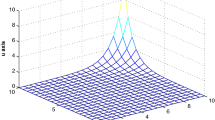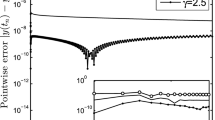Abstract
Due to the merit of transforming fractional differential equations into ordinary differential equations, the Yuan and Agrawal method has gained a lot of research interests over the past decade. In this paper, this method is improved with major emphasis on enhancing the convergence rate. The key procedure is to transform fractional derivative into an improper integral, which is integrated by Gauss–Laguerre quadrature rule. However, the integration converges slowly due to the singularity and slow decay of the integrand. To solve these problems, we reproduce the integrand to circumvent the singularity and slow decay simultaneously. With the reproduced integrand, the convergence rate is estimated to be no slower than \( \, O(n^{ - 2} ) \) with \( n \) as the number of quadrature nodes. In addition, we utilize a generalized Gauss–Laguerre rule to further improve the accuracy. Numerical examples are presented to validate the rapid convergence rate of the improved method, without causing additional computational burden compared to the original approach.





Similar content being viewed by others
References
Hilfer R (2000) Applications of fractional calculus in physics. World Scientific Publishing Co. Pte. Ltd, Singapore
Yin C, Chen YQ, Zhong SM (2014) Fractional-order sliding mode based extremum seeking control of a class of nonlinear systems. Automatica 50(12):3173–3181
Rossikhin YA, Shitikova MV (2010) Application of fractional calculus for dynamic problems of solid mechanics: novel trends and recent results. Appl Mech Rev 63(1):010801
Freed AD, Diethelm K (2006) Fractional calculus in biomechanics: a 3D viscoelastic model using regularized fractional derivative kernels with application to the human calcaneal fat pad. Biomech Model Mech 5(4):203–215
Podlubny I (1998) Fractional differential equations: an introduction to fractional derivatives, fractional differential equations, to methods of their solution and some of their applications. Elsevier, London
Metzler R, Klafter J (2000) The random walk’s guide to anomalous diffusion: a fractional dynamics approach. Phys Rep 339(1):1–77
Sokolov IM, Klafter J, Blumen A (2000) Ballistic versus diffusive pair dispersion in the Richardson regime. Phys Rev E 61(3):2717–2722
Del-Castillo-Negrete D, Carreras BA, Lynch VE (2003) Front dynamics in reaction-diffusion systems with Levy flights: a fractional diffusion approach. Phys Rev Lett 91(1):018302
Diethelm K, Ford NJ, Freed AD (2002) A predictor-corrector approach for the numerical solution of fractional differential equations. Nonlinear Dyn 29(1–4):3–22
Meerschaert MM, Charles T (2004) Finite difference approximations for fractional advection–dispersion flow equations. J Comput Appl Math 172(1):65–77
Diethelm K, Ford NJ, Freed AD, Luchko Y (2005) Algorithms for the fractional calculus: a selection of numerical methods. Comput Method Appl Mech 194(6):743–773
Ford NJ, Simpson AC (2001) The numerical solution of fractional differential equations: speed versus accuracy. Numer Algorithm 26(4):333–346
Lei SL, Sun HW (2013) A circulant preconditioner for fractional diffusion equations. J Comput Phys 242(3):715–725
Pan JY, Ke RH, Ng MK, Sun HW (2014) Preconditioning techniques for diagonal-times-Toeplitz matrices in fractional diffusion equations. SIAM J Sci Comput 36(6):A2698–A2719
Bai YQ, Huang TZ, Gu XM (2015) Circulant preconditioned iterations for fractional diffusion equations based on Hermitian and skew-Hermitian splittings. Appl Math Lett 48:14–22
Fu H, Wang H (2017) A preconditioned fast finite difference method for space-time fractional partial differential equations. Fract Calc Appl Anal 20(1):88–116
Lischke A, Zayernouri M, Karniadakis GE (2017) A Petrov–Galerkin spectral method of linear complexity for fractional multiterm ODEs on the half line. SIAM J Sci Comput 39(3):A922–A946
Yuan L, Agrawal OP (2002) A numerical scheme for dynamic systems containing fractional derivatives. J Vib Acoust 124:2321–2324
Singh SJ, Chatterjee A (2006) Galerkin projections and finite elements for fractional order derivatives. Nonlinear Dyn 45(1):183–206
Atanackovic TM, Stankovic B (2008) On a numerical scheme for solving differential equations of fractional order. Mech Res Commun 35(7):429–438
Tang S, Ying Y, Lian Y, Lin S, Yang Y, Wagner GJ, Liu WK (2016) Differential operator multiplication method for fractional differential equations. Comput Mech 58(5):1–10
Trinks C, Ruge P (2002) Treatment of dynamic systems with fractional derivatives without evaluating memory-integrals. Comput Mech 29:471–476
Diethelm K (2008) An investigation of some nonclassical methods for the numerical approximation of Caputo-type fractional derivatives. Numer Algorithm 47:4361–4390
Lu JF, Hanyga A (2005) Wave field simulation for heterogeneous porous media with singular memory drag force. J Comput Phys 208(2):651–674
Birk C, Song C (2010) An improved non-classical method for the solution of fractional differential equations. Comput Mech 46(5):721–734
Lian Y, Wagner GJ, Liu WK (2017) A Meshfree method for the fractional advection-diffusion equation. In: Griebel M, Schweitzer M (eds) Meshfree methods for partial differential equations VIII. Lecture Notes in Computational Science and Engineering, vol 115. Springer, Cham
BhrawyAH Baleanu AHB, Taha TM (2013) A modified generalized Laguerre spectral method for fractional differential equations on the half line. Abstr Appl Anal 2013(3):1401–1429
Capobianco MR, Criscuolo G (2007) Some remarks on the numerical computation of integrals on an unbounded interval. Numer Algorithm 45(1–4):37–48
Mastroianni G, Monegato G (1995) Convergence of product integration rules over (0, ∞) for functions with weak singularities at the origin. Math Comput 64(209):237–249
Leung AYT, Guo Z (2011) Forward residue harmonic balance for autonomous and non-autonomous systems with fractional derivative damping. Commun Nonlinear Sciand Numer Simul 16(4):2169–2183
Khang NV, Thuy BT, Chien TQ (2016) Resonance oscillation of third-order forced van der Pol system with fractional-order derivative. J Comput Nonlinear Dyn 11(4):041030
Acknowledgements
This work is supported by the National Natural Science Foundation of China (41030331, 11572356, 11672337).
Author information
Authors and Affiliations
Corresponding author
Appendix: Determination of initial conditions for general system of Eq. (26)
Appendix: Determination of initial conditions for general system of Eq. (26)
Consider a more general form of Eq. (26)
where \( z = [z_{1} ,z_{2} , \ldots ,z_{r} ]^{T} \) is the r-dimensional unknown vector and A denotes a matrix of dimension \( r \times r \). For simplicity, we assume that \( f(t) \) at t = 0 can be expanded as
herein \( 0 < \gamma_{1} < \cdots < \gamma_{s} \le 1 \), and \( o(t) \) denotes higher order terms. To determine initial condition \( z^{'} (0) \), we need to estimate the asymptotic behavior of \( z \) as \( t \) approaches 0. To do so, we approximate the solution of Eq. (A1) as [5]
where the coefficients are \( \bar{c}_{i} = \frac{B(\beta ,1 - \alpha )\beta }{\Gamma (1 - \alpha )}c_{i} \) with \( B(\beta ,1 - \alpha ) \) as the Beta function being defined as \( B(\beta ,1 - \alpha ) = \int_{0}^{1} {x^{\beta - 1} (1 - x)^{1 - \alpha - 1} } dx \), and \( d_{1} = \lambda \Gamma (\lambda )(Az(0) + f(0)) \) and \( d_{l + 1} = \frac{(l + 1)\lambda B((l + 1)\lambda ,1 - \lambda )}{\Gamma (1 - \lambda )}d_{l} \) with \( l = 1,2, \ldots ,L - 1 \).
Note that, there is singularity in \( z^{'} (0) \) according to Eq. (A3) as long as there are fractional powers lower than \( t \). Before applying the improved method, we should first eliminate the singularity. Assume all the fractional powers lower than \( t \) in (A3) are \( \sum\limits_{l = 1}^{{L_{1} }} {d_{l} t^{l\lambda } } + \sum\limits_{i = 1}^{{S_{1} }} {\bar{c}_{i} t^{{\lambda + \gamma_{i} }} } \) where \( L_{ 1} \lambda < 1\le (L_{ 1} + 1)\lambda \) and \( \lambda + \gamma_{{S_{ 1} }} < 1 \le \lambda + \gamma_{{S_{ 1} + 1}} \). Introduce a transformation \( y(t) = z(t) - z(0) - \sum\limits_{l = 1}^{{L_{1} }} {d_{l} t^{l\lambda } } - \sum\limits_{i = 1}^{{S_{1} }} {\bar{c}_{i} t^{{\lambda + \gamma_{i} }} } \) to Eq. (A1), we have
where \( f_{1} (t) = d_{{L_{1} }} t^{{L_{1} \lambda }} + c_{{S_{1} }} t^{{\gamma_{{S_{1} }} }} + {\text{higher terms}} \) which yields a solution being approximated as
Based on Eq. (A5), \( y^{{\prime }} (0) \) can be determined as: (1) \( y^{{\prime }} (0) = \bar{d}_{{L_{1} }} + \bar{c}_{{S_{1} }} \) if \( (L_{ 1} + 1)\lambda = \gamma_{{S_{1} }} + \lambda = 1 \); or (2) \( y^{{\prime }} (0) = \bar{d}_{{L_{1} }} \) if \( (L_{ 1} + 1)\lambda = 1 \) and \( \gamma_{{S_{1} }} + \lambda > 1 \); or (3) \( y^{{\prime }} (0) = \bar{c}_{{S_{1} }} \) if \( (L_{ 1} + 1)\lambda > 1 \) and \( \gamma_{{S_{1} }} + \lambda = 1 \); otherwise (4) \( y^{{\prime }} (0) = 0 \) if \( (L_{ 1} + 1)\lambda > 1 \) and \( \gamma_{{S_{1} }} + \lambda > 1 \). After determining the initial condition \( y^{{\prime }} (0) \), the improved method is employed to solve Eq. (A4) rather than (A1).
As for Eq. (26) with \( f(t) = \frac{1}{\Gamma (2 - \lambda )}t^{ 1- \lambda } + t + o(t) \) and \( z(0) = 0 \), by using the above procedures we obtain the initial condition as \( z^{{\prime }} (0) = 1 \).
Rights and permissions
About this article
Cite this article
Liu, Q.X., Chen, Y.M. & Liu, J.K. An improved Yuan–Agrawal method with rapid convergence rate for fractional differential equations. Comput Mech 63, 713–723 (2019). https://doi.org/10.1007/s00466-018-1621-6
Received:
Accepted:
Published:
Issue Date:
DOI: https://doi.org/10.1007/s00466-018-1621-6




